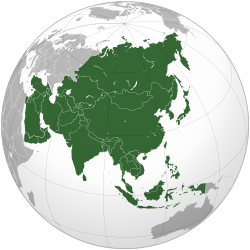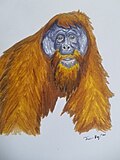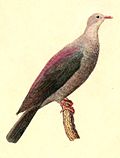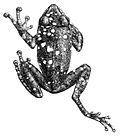
This is a list of Asian animals extinct in the Holocene that covers extinctions from the Holocene epoch, a geologic epoch that began about 11,650 years before present (about 9700 BCE) [a] and continues to the present day. [1]
Contents
- Mammals (class Mammalia)
- Elephant-like mammals (order Proboscidea)
- Sea cows (order Sirenia)
- Lagomorphs (order Lagomorpha)
- Rodents (order Rodentia)
- Primates (order Primates)
- Bats (order Chiroptera)
- Carnivorans (order Carnivora)
- Odd-toed ungulates (order Perissodactyla)
- Even-toed ungulates (order Artiodactyla)
- Birds (class Aves)
- Ostriches and fossil relatives (order Struthioniformes)
- Landfowl (order Galliformes)
- Waterfowl (order Anseriformes)
- Pigeons and doves (order Columbiformes)
- Rails and cranes (order Gruiformes)
- Shorebirds (order Charadriiformes)
- Boobies, cormorants, and relatives (order Suliformes)
- Pelicans, herons, and ibises (order Pelecaniformes)
- Hawks and relatives (order Accipitriformes)
- Owls (order Strigiformes)
- Hornbills and hoopoes (order Bucerotiformes)
- Kingfishers and relatives (order Coraciiformes)
- Woodpeckers and allies (order Piciformes)
- Parrots (order Psittaciformes)
- Perching birds (order Passeriformes)
- Reptiles (class Reptilia)
- Crocodilians (order Crocodilia)
- Squamates (order Squamata)
- Turtles and tortoises (order Testudines)
- Amphibians (class Amphibia)
- Frogs (order Anura)
- Salamanders (order Urodela)
- Ray-finned fish (class Actinopterygii)
- Sturgeons and paddlefishes (order Acipenseriformes)
- Herrings and anchovies (order Clupeiformes)
- Minnows and allies (order Cypriniformes)
- Catfishes (order Siluriformes)
- Salmon, trout and relatives (order Salmoniformes)
- Gobies and relatives (order Gobiiformes)
- Cichlids and convict blennies (order Cichliformes)
- Silversides and rainbowfishes (order Atheriniformes)
- Cartilaginous fish (class Chondrichthyes)
- Ground sharks (order Carcharhiniformes)
- Shovelnose rays and allies (order Rhinopristiformes)
- Malacostracans (class Malacostraca)
- Amphipods (order Amphipoda)
- Insects (class Insecta)
- Dragonflies and damselflies (order Odonata)
- Beetles (order Coleoptera)
- Arachnids (class Arachnida)
- Order Sarcoptiformes
- Clitellates (class Clitellata)
- Order Opisthopora
- Slugs and snails (class Gastropoda)
- Order Stylommatophora
- See also
- Notes
- References
- External links
This list includes the Asian continent and its surrounding islands, including Cyprus. The three Transcaucasian republics of Georgia, Armenia, and Azerbaijan are included in the List of European species extinct in the Holocene, even though their territory may fall partially or fully in Asia depending on the definition of Europe considered. Species from Western New Guinea (Indonesia), the Aru Islands (Indonesia), and Christmas Island (Australia) are listed in the List of Australia-New Guinea species extinct in the Holocene.
Many extinction dates are unknown due to a lack of relevant information.



































































































